Article and all photos by JILL BOOGREN
 Butterfly lovers from around the Twin Cities and region gathered at Nokomis Park on a gloriously sunny Saturday in September to celebrate the littlest members of royalty at the seventh annual Minneapolis Monarch Festival—Festival de la Monarca. Kids and adults alike wore colorful wings, created art, enjoyed live music, and helped newly-emerged adult monarchs take flight.
Butterfly lovers from around the Twin Cities and region gathered at Nokomis Park on a gloriously sunny Saturday in September to celebrate the littlest members of royalty at the seventh annual Minneapolis Monarch Festival—Festival de la Monarca. Kids and adults alike wore colorful wings, created art, enjoyed live music, and helped newly-emerged adult monarchs take flight.
Photo left: Angie Courchaine, Chicks on Sticks, spreads her wings.
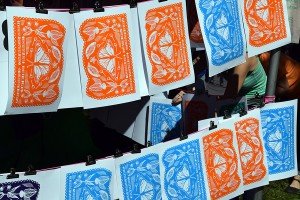 Photo right: Monarch prints hanging to dry read “Plant Milkweed / Grow Monarchs.”
Photo right: Monarch prints hanging to dry read “Plant Milkweed / Grow Monarchs.”
Already at 10am a line was forming outside the University of Minnesota Monarch Lab. Inside the lab, volunteers demonstrated the monarch life cycle, from caterpillar to chrysalis to butterfly. They explained their diets—milkweed for caterpillars, nectar for butterflies—and showed how to distinguish between female and male monarchs (males have two black dots on their hind wings). They then tagged monarchs with a tracking sticker and released them.
Young Amelia and Maeta Donald, together with their family for their second time at the festival, learned about the butterflies inside the lab then helped release a monarch outdoors.
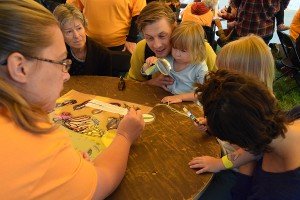 “That’s the highlight for us, seeing the butterflies up close,” said their dad, Matt Donald.
“That’s the highlight for us, seeing the butterflies up close,” said their dad, Matt Donald.
Photo right: Amelia Donald takes a turn with the magnifying glass in the Monarch Lab.
The lab releases monarchs they’ve raised as well as those raised by volunteers who bring them to the festival. Over 100 monarchs were expected to be released throughout the day.
The Larsen and Staloch families, from Bloomington, have been coming to the festival since it started. They raise monarchs they’ve brought to the Monarch Lab.
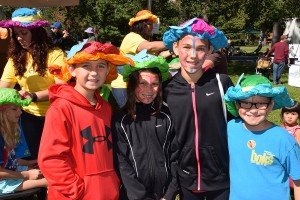 Their favorite part about raising monarchs? “That you get to let them go,” said Jackie Larsen. Annie Staloch added, “You get to see the life cycle.”
Their favorite part about raising monarchs? “That you get to let them go,” said Jackie Larsen. Annie Staloch added, “You get to see the life cycle.”
Photo left: From left: Andy Larsen, Annie Staloch, Jackie Larsen, and Nick Staloch sporting their paper hats with butterflies made by Onelia Rios (behind, in the blue hat), and Josselin Cano (orange hat) of el Valor, an early Head Start program in Chicago. The Larsen and Staloch families, from Bloomington, have been coming to the Monarch Festival since it started. They raise monarchs and have brought them to the Monarch Lab for release.
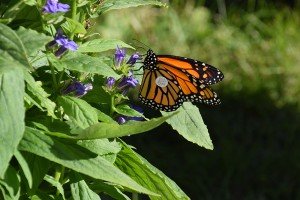 A tagged butterfly—their tags are noticeable when wings are closed and upright—was spotted early in the morning getting nourishment from the Great Blue Lobelia plant at the Wild Ones exhibit.
A tagged butterfly—their tags are noticeable when wings are closed and upright—was spotted early in the morning getting nourishment from the Great Blue Lobelia plant at the Wild Ones exhibit.
Photo right: You can identify the tag on the butterfly wing.
“This generation is going to fly to Mexico,” said Vicki Bonk, who has been part of the Nokomis Naturescape and Monarch Festival since their inception. Monarchs will migrate an astounding 2,300 miles to the mountains of Michoacán, Mexico, where they will spend the winter with millions of other monarchs. The butterflies start heading north again in March, and it takes two or three generations to get back to Minnesota. This means each fall a brand new generation of monarchs makes the journey south. Even though they have never been there before they end up in the same place as their ancestors—often in the exact same trees — adding to the wonder of this incredible natural cycle.
Throughout the festival people enjoyed tacos, pineapple, ice cream, and other treats. Art tables were full of people printing monarch flags, making colorful hats, and sculpting clay ornaments. A costume parade, led by Angie Courchaine of Chicks on Sticks, saw a trail of wings wend its way through the park.
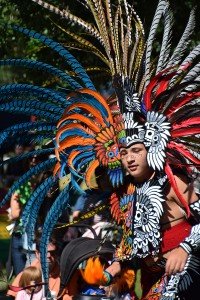 Performers with Kalpulli Yaocenoxtli in full-feathered regalia drew a huge crowd with their rhythmic dancing in the Aztec/Mexica tradition. “Mexica” is the traditional word for their ancestors, explained performer Sergio Quiroz. Many audience members jumped at the chance to learn a dance with them at the end of the show.
Performers with Kalpulli Yaocenoxtli in full-feathered regalia drew a huge crowd with their rhythmic dancing in the Aztec/Mexica tradition. “Mexica” is the traditional word for their ancestors, explained performer Sergio Quiroz. Many audience members jumped at the chance to learn a dance with them at the end of the show.
Photo left: Oskar Ramos dances.
 Photo right: The audience gets up to learn some dance steps with Kalpulli Yaocenoxtli.
Photo right: The audience gets up to learn some dance steps with Kalpulli Yaocenoxtli.
The festival is a collaboration between Nokomis East Neighborhood Association, Minneapolis Park and Recreation Board, the University of Minnesota Monarch Lab, Wild Ones, and others. Bonk emphasized the importance of volunteers to make the festival happen and to nurture the four-acre Nokomis Naturescape—a monarch waystation. Volunteers of Wild Ones Twin Cities are the primary stewards of the Naturescape, which is planted with milkweed and nectar-producing native plants. They’re there every Tuesday from early spring through fall, where they plant, weed, and sometimes water the gardens by hauling up jugs of water from the lake. They need and welcome more volunteers.
“Our dream is that people would adopt a section and be chief cook and bottle washer of that section—adopt-a-plot, an area they always groom,” said Wild Ones President Marilyn Jones. “We know our native. We love to work with learners.”
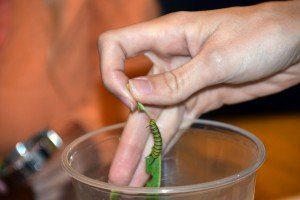 Photo right: A monarch caterpillar depends on milkweed to grow and develop.
Photo right: A monarch caterpillar depends on milkweed to grow and develop.
Monarch populations have been in decline in large part due to habitat loss. For those interested in planting a monarch waystation, here are a few tips: use native plants, as they’re accustomed to our climate and soil; provide butterfly nectar plants and especially milkweed, so caterpillars have a source of food; and avoid using pesticides.
Learn how to collect and plant milkweed seeds at a Milkweed for Monarchs Workshop, Sat. Oct. 10, 1-2pm, at Nokomis Community Center.
For more information see wildonestwincities.org, monarchlab.org, monarchwatch.org, and monarchfestival.org.
Comments
No comments on this item Please log in to comment by clicking here